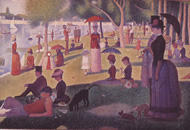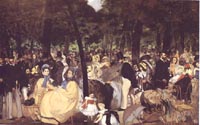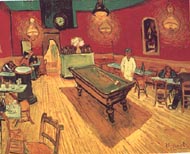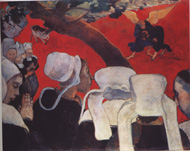Signac: "Art is a creation of a higher order than a copy of nature which is governed by chance.... By the elimination of all muddy colors, by the exclusive use of optical mixture of pure colors, by a methodical divisionism and a strict observation of the scientific theory of colors, the neo-impressionists insures a maximum of luminosity, of color intensity, and of harmony- a result that has never yet been obtained.
Cezanne: "One must reflect. The eye is not enough, reflection is needed....I want to make of Impressionism something lasting and like the art in the museums....Art is a harmony parallel to nature.... Drawing and color are not distinct. As one paints, one draws. The more harmonious the color, the more accurate the drawing. When color is richest, form is most complete. The secret of drawing and modelling lies in contrast and relations of tone. Color must reveal interval in depth.
Van Gogh, "Instead of trying to reproduce exactly what I have before my eyes, I use color more arbitrarily so as to express myself forcibly...."
Van Gogh, describing Night Cafe: "to express the terrible passions of humanity...the idea that the cafe is a place where a man can lose his mind, commit crime...an atmosphere of a glowing inferno, plane suffering, the dark powers that rule over man in his sleep."
Van Gogh, referring to Starry Night: "That does not prevent me from having a terrible need of-shall I say the word-of religion. Then I go out at night to paint the stars...."
Gauguin: "Don't copy nature too much. Art is an abstraction; derive this abstraction from nature while dreaming before it, but think more of creating than of actual result. The only way to rise towards God is by doing as our Divine master does, create...."
Web-links
Van Gogh's
Van Goghs, a virtual tour of the exhibition held at the National Gallery
of Art in Washington from October 1998 to January 1999.

|

|
| Seurat, Grande Jatte, 1884-6. | Manet, Concert at the Tuileries, 1862. |
Signac, a colleague of Seurat, stated: "Art is a creation of a higher order than a copy of nature which is governed by chance." Discuss this quotation in relationship to Seurat's reaction to Impressionism evident in this comparison. Also define Seurat's indebtedness to Impressionism.

|

|
| Van Gogh, Night Cafe, 1888. | Gauguin, Vision after the Sermon, 1888. |
For Gauguin and Van Gogh, reality resided not in the outside world but inwardly- the world of feelings and emotions. In this comparison show how the artists have exploited the formal elements of painting to represent their "inner worlds."